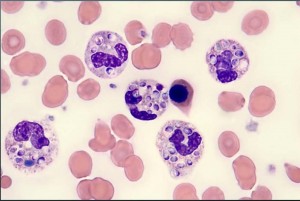Histoplasmomas of Uncommon Size
 Histoplasma capsulatum infection demonstrates a broad spectrum of acute and chronic clinical manifestations. Unlike the acute reaction to proliferating organisms, the chronic complications are often the result of excessive or prolonged host response with a paucity of organisms. Lung nodules (histoplasmomas) may be noted decades after initial infection and present a challenging clinical problem, as they can be difficult to distinguish from malignancy or tuberculomas. Typically, histoplasmomas are small (< 1 cm), asymptomatic, and may be stable in size or slowly enlarge over time. Here we report three patients with unusually large, or giant, histoplasmomas (> 3 cm) and describe their extreme phenotype. Importantly, two of the patients presented with subacute symptomatic disease, a presentation that is very atypical for histoplasmoma. The term “buckshot” calcification has been used to describe dozens of small (2-4 mm) calcified nodules, so it may be appropriate to label masses that exceed 3 cm as “cannonball” histoplasmoma.
Histoplasma capsulatum infection demonstrates a broad spectrum of acute and chronic clinical manifestations. Unlike the acute reaction to proliferating organisms, the chronic complications are often the result of excessive or prolonged host response with a paucity of organisms. Lung nodules (histoplasmomas) may be noted decades after initial infection and present a challenging clinical problem, as they can be difficult to distinguish from malignancy or tuberculomas. Typically, histoplasmomas are small (< 1 cm), asymptomatic, and may be stable in size or slowly enlarge over time. Here we report three patients with unusually large, or giant, histoplasmomas (> 3 cm) and describe their extreme phenotype. Importantly, two of the patients presented with subacute symptomatic disease, a presentation that is very atypical for histoplasmoma. The term “buckshot” calcification has been used to describe dozens of small (2-4 mm) calcified nodules, so it may be appropriate to label masses that exceed 3 cm as “cannonball” histoplasmoma.
Histoplasma capsulatum is a dimorphic fungus found throughout the world, with particularly high seroprevalence rates in the Ohio and Mississippi River Valleys of the United States. With rare exceptions, infection results from inhalation of spores. Although the majority of exposures do not lead to significant disease, a variety of pulmonary manifestations have been described depending on degree of exposure, immune status of the host, and presence or absence of structural lung disease. Initial infection may be asymptomatic or result in acute or subacute pneumonia with or without mediastinal adenitis. As the disease resolves, focal areas of infiltrate may coalesce to form nodules that slowly enlarge and calcify over time. Prior to their initial description by Puckett in 1953, these “histoplasmomas” were frequently mistaken for malignant tumors or tuberculomas.
In 1969, Goodwin and Snell reported a series of 17 patients with surgically resected histoplasmomas that ranged in size from 8 to 35 mm. Eight patients in the series had serial imaging over a period of 25 to 116 months, and among these patients the average rate of increase in diameter was just under 2 mm/y. Here we describe three patients who developed multiple, unusually large histoplasmomas, which to our knowledge has not been previously reported.
You can find more information about histoplasma – click here.